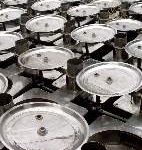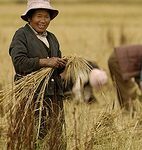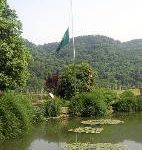In far western and north-western China, semi-nomadic herders huddle in their remote homes on winter nights, and in their tents in summer, straining to see in the dim, smoky light provided by kerosene lamps, butter lamps and candles. Among the poorest people in the country, these traditional herders have little cash income and may barter or sell a yak or a sheep when they need money.
Much of this region – spread over nine provinces — is very cold and very high, sometimes as high as 4,000 metres above sea level. In Qinghai province, herders tend their animals in the relative shelter of mountain valleys in winter, then move with them to higher grazing ground in summer. In similarly distant and sparsely populated farming areas — in places such as Inner Mongolia, Gansu and Sichuan — the story is much the same. Life is harsh. The rural people often live far from their nearest neighbours and have limited access to goods and services – particularly the luxury of power-grid electricity.
Things have been changing for the better in the recent years, though.
Increasingly, high-quality and affordable solar lighting has come to the region, thanks to China’s Renewable Energy Development Project (REDP). Set up in 2001 by the National Development and Reform Commission (NRDC) and the World Bank, with international grant financing by the Global Environment Facility (GEF), the Chinese project won (in June 2008) a nearly US$40,000 Ashden Awards prize for sustainable energy.
From the programme’s inception until the middle of this year, 402,000 photovoltaic (PV) solar home systems have been installed (through a subsidised programme) in remote, off-grid dwellings in northern and north-western China. These solar home systems (SHS) are stand-alone electrical units, using a PV module to provide power. A typical SHS, supplied in a metal carrying case so it is easily transportable, can power two lights and charge a mobile phone. (Radio-cassette players, televisions and DVD players can be plugged into larger systems.)
Luo Xinlian, REDP’s technical and innovations manager, says the systems have benefitted 1.61 million people so far — “especially in Tibet” — based on an average of four people per household. The systems, she adds, have brought new opportunities to those who use them and have improved the quality of their domestic lives.
“This is an extremely important programme,” says Sarah Butler-Sloss, the founder and chair of the Ashden Awards. It has “supported the rapid growth of the PV industry in China and improved the quality of production while keeping costs low. It greatly expanded the market for solar home systems and supported the development of a network of suppliers, wholesalers and retailers.”
Bright, high-quality electric light is a huge benefit, allowing adults to do more at home in the evenings, while schoolchildren can study for longer each day. Candles and kerosene and butter lamps – apart from being dim and smoky – can be knocked over easily, presenting a significant fire hazard. By allowing for more evening activities in villages, REDP says, the lighting systems help to strengthen community ties.
In some areas, larger solar systems supply electricity to light schools, health clinics, roadside shops and restaurants, as well as Buddhist temples and academies, while also powering village satellite telephones, flood alarm systems, climate-monitoring stations and other public services. (“Having solar power means we don’t have to stop lessons when the daylight ends,” says one head teacher whose school benefitted from the project. Meanwhile, a yak herder delights in listening to music, thanks to his portable power system, “when we go up to the summer pastures”.)
A World Bank survey of four Chinese counties showed that 58% of SHS energy output is used for lighting, while about 38% powers radios. This important link to the outside world provides learning and entertainment opportunities, as well as a greater sense of security (especially in the summer pastures) for the people. Other appliances – such as cassette and DVD players and televisions – account for about 4% of the energy use. (The phone-charging function is not always functional, however; in the more remote areas, telecommunications networks serve only the villages, with their clustered homes.)
There also have been environmental benefits to SHS, even in these regions where environmental footprints are so small: a reduction of greenhouse gases through use of renewable solar energy, as opposed to the household pollution created by smoke-producing non-renewable kerosene and candles. REDP has created some 1,500 permanent jobs and 3,000 temporary ones through its network of about 80 SHS local retail suppliers and 32 wholesalers. As the programme expanded, increasingly strict standards on product quality, service and management were put into place.
“We have accomplished all our targets under our grant,” Luo says. As of the end of June 2008 – Ashden Award in hand – the REDP programme closed as planned. But that is not the end of the story. REDP is evolving into the China Photovoltaic Industry Association, which will continue – and go beyond – the original programme’s work. The new organisation will provide consulting services, a business-to-business website and, every two years, a development report on China’s PV industry.
Sales now continue without subsidies, because the benefits of PV are widely known, and the systems are reliable and accessible. The local people clearly see the benefits and want the systems. Some homes have upgraded to larger, or even two, systems – to light more rooms for longer, or to power more appliances, such as televisions. Farmers can sell their produce at regional markets and return home with newly purchased solar PV modules in their donkey-drawn carts.
Using between 10 and 500 watt-peak (Wp) PV capacity, the systems provided by REDP consist of a PV module, a battery, a charge controller (regulator) and sometimes an electrical inverter, plus light bulbs and a direct-current (DC) socket for a radio or phone charger. The home systems now have a total megawatt peak capacity of 11.1, or a 28-watt-peak average per system. The average sale price of a SHS in 2007 was 1,221 yuan (about $USD175) – similar to the price of a yak.
Buyers of the system usually pay the full retail price in a single payment, although in some areas local or regional authorities have arranged grants to help with purchases and competitive retailers may offer credit arrangements or price discounts. In a small minority of cases, says REDP, the authorities have bought systems in bulk and distributed them free or at half price.
The PV module represents about 50% of the system’s cost. Because the modules are low-cost and made in China, the retail prices for SHS units are inexpensive by international standards. With the end of the subsidy to retailers, prices are expected to rise by about 20%, however. Dealers – who can carry out basic repairs and replacements — say the systems are reliable. When they do malfunction, the main problems are caused by short-circuits and overloading with appliances.
The modules are guaranteed for 10 years but are expected to last for twice that long. Warranties also are provided for other components: two years for charge controllers, a year for batteries, inverters and lights. Simple drawings in Mandarin Chinese and local-language leaflets demonstrate, even to illiterate people, how the systems work. (In a warning that PV modules are fragile, one illustration – marked with a red “X” – shows a yak head-butting a solar panel.)
Given that China plans to double its renewable energy capacity by 2020, REDP sees huge opportunities for expanding the SHS market. “Solar PV is the key to rural electrification,” says Luo, citing a target of 300 MWp of rural PV energy – in off-grid and local PV grid power – over the next 12 years.
In addition to supplying “a huge number of people with sustainable energy in a way that meets their needs,” according to Ashden’s Butler-Sloss, “this model is now being used by several other donor-funded programmes in China.” Indeed, says REDP’s photovoltaic manager, Wang Wei, the World Bank is encouraging a similar system in other developing countries, including the Philippines, Mongolia, Sri Lanka and Bolivia.
As Butler-Sloss points out, energy pioneers like REDP are showing “practical and intelligent ways forward” in a world “where two billion people still don’t have access to modern forms of energy, where fuel prices are escalating and where the impacts of climate change are increasingly evident”. By harnessing the renewable power of water, wind and sun, “they demonstrate easily achievable steps for making energy savings. They show us the future.”
Even amid the nomads and their yaks in China’s far-off mountains and summer pastures.
Maryann Bird is associate editor of chinadialogue




